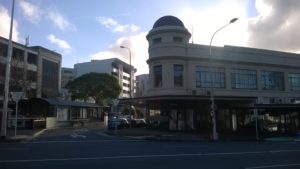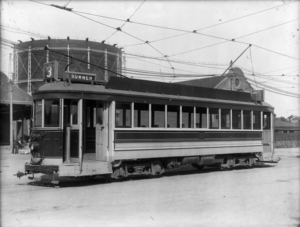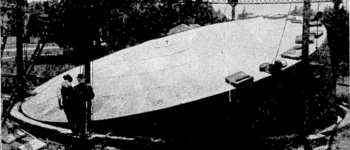1960s: Gasometer’s Demise
April 22, 2019
By AHNZ
 For most of New Zealand’s industrial history, especially before electricity, towns had their own on-site coal gasworks to produce the energy for lighting, cooking, and heating. Until the 1960s/70s the state of technology dictated on-site storage; Thus the ubiquitous gasometer.
For most of New Zealand’s industrial history, especially before electricity, towns had their own on-site coal gasworks to produce the energy for lighting, cooking, and heating. Until the 1960s/70s the state of technology dictated on-site storage; Thus the ubiquitous gasometer.
 Reluctantly I accept ‘gasometer’ is an accurate title for a giant gas silo although it’s not the same sort of thing as an odometer or chronometer. Because they would rise and fall (‘breathe’,) fill and empty, one could tell at a glance how much gas energy your town was sitting on and if it was in need of charging back up. So, quite a bit like the battery indicator picture on a cell phone.
Reluctantly I accept ‘gasometer’ is an accurate title for a giant gas silo although it’s not the same sort of thing as an odometer or chronometer. Because they would rise and fall (‘breathe’,) fill and empty, one could tell at a glance how much gas energy your town was sitting on and if it was in need of charging back up. So, quite a bit like the battery indicator picture on a cell phone.
The State, in the form of local government, frequently or always became mixed up in building and running and deficit financing these little power plants. As such, they frequently broke down or never worked or were slow to be established. In 1935 Woodville Borough Council’s gasometer floated up too much and capsized (see image above.) Dunedin City spent millions on a record-sized one in 1908 that never worked and they had to start again at great cost of time, bureaucratic inquiries, and embarrassment.
 Auckland Cities Beresford Street gasometer [ref image] was said to be the largest in Australasia when built back in 1911. Before the motorway came this street ran all the way up Pitt St where the old domed gas company building (ref image) still stands today (ref. image, Google Streetview 2017.) Yet even now electricity was beginning to out-compete the gas energy as the picture of this Christchurch tram with gasometer behind aptly illustrates (see below.) By 1950 New Zealand had 44 gasworks but 97 electric plants. By our own lifetimes the outdated and derelict structures were eyesores waiting to be demolished. Because it was a role for the state they often lingered on unattractively as did the Beresford Street installation until the late 1980s.
Auckland Cities Beresford Street gasometer [ref image] was said to be the largest in Australasia when built back in 1911. Before the motorway came this street ran all the way up Pitt St where the old domed gas company building (ref image) still stands today (ref. image, Google Streetview 2017.) Yet even now electricity was beginning to out-compete the gas energy as the picture of this Christchurch tram with gasometer behind aptly illustrates (see below.) By 1950 New Zealand had 44 gasworks but 97 electric plants. By our own lifetimes the outdated and derelict structures were eyesores waiting to be demolished. Because it was a role for the state they often lingered on unattractively as did the Beresford Street installation until the late 1980s.

I speculate that gasworks and gasometers played a large part in expanding state power at a local level from about the 1860s in New Zealand.* Civic pride was leveraged into political promises, votes, debts, and decades-long derelict white elephants. Most of all, they were the vehicle to convince freedom-loving colonial New Zealanders that for big projects they needed government involvement and direction. That they needed permission to dig in their own soil now, least they hit a pipe. That their sustaining energy came to them courtesy of a public umbilical pipe feeding from a giant glorified floating cork.
—
* The Coalminers Unions were doubtless up to their sooty eyebrows in it too. More gasometers, more coal!
Ref. The Rise and Fall of the Gasometer, Tom Scott; Youtube
Ref. S. P. Skinner Photo; ‘CAUSED BY THE HEAT OF THE SUN’
Ref. William Archer Price, Beresford Street 1920s
Ref. Beresford Street 2018; AHNZ files
Ref. Chch tram, 1922; Alexander Turnbull
 Like Comment Share
Like Comment Share





